|
|
2419 Displayed as B 390 |
|

This scanned photo shows
2419 at the NSWRTM Thirlmere during April 1985, displayed with a round-top
boiler as B 390.
In the background is
Beyer-Garratt 6040 prior to its static restoration.
The area immediately behind these locomotives is now the
new Trainworks roundhouse and workshop.
|
Builder |
Dubs
& Co, Glasgow |
|
Builder’s Number & Year |
2641 of 1891 |
|
Wheel Arrangement |
2-6-0 |
|
No. in class |
25 |
|
The
B(55) class 2-6-0 locomotives (later renamed the (Z)24
class) were ordered from Dubs & Co, Glasgow in 1889, at a time when the
NSWGR was desperately short of motive power.
The 2-6-0 wheel arrangement had been favoured for main-line freight
locomotives during the early 1880's but the NSWGR already had larger and more
powerful 2-8-0 locomotives on order by 1889.
These were the 25 “Native Bear” 2-8-0’s of the J(522)
class, conceived as a local copy of the Baldwin J(131) class, but the order fell
through when the local manufacturer was unable to complete construction. In response, the NSWGR urgently ordered more
2-6-0 locomotives for main-line freight duties, this time opting for a proven
supplier to augment the fleet of similar B(205) / (Z)25
class 2-6-0 locomotives. The
(Z)24 class locomotives were originally supplied
with round-top boilers, sloping smokeboxes and stovepipe chimneys. As boiler renewals became necessary between
1903 and 1908 they received Belpaire boilers, new
smokeboxes and cast-iron chimneys. The
class were delivered with Thow "porthole window" cabs and retained
this feature throughout their lives. In
1892, Dubs & Co also supplied to the NSWGR twenty 2-6-2ST locomotives of
the I(17) class. These engines were essentially a saddle-tank
version of the B(55) class and were intended for
mineral trains and banking duties over steeply-graded routes. These twenty locomotives became the (Z)26 class at the 1924 renumbering. The
B(55) / (Z) 24 class were successful in the heavy freight role until displaced
by “Standard Goods” 2-8-0 engines, gravitating to secondary lines before being
ousted in the 1930’s by newly converted (C)30T class engines. Some (Z)24’s continued
in shunting roles, while many were sold to private users including collieries
and sand & gravel quarries. 2415
was sold to BHP and converted to 0-6-0ST configuration for steelworks
shunting! Preserved
locomotive 2419 was built in 1891 as Dubs & Co builder's number 2641,
receiving the NSWGR number B 390 when first issued to traffic. It became 2419 of the (Z)24
class at the 1924 renumbering and remained with the NSWGR though its working
career. Upon withdrawal it was
fortunate to be selected for the collection of the formative New South Wales Rail
Transport Museum, which was being established at Enfield locomotive depot. Here it was returned to near-original
appearance by replacing the Belpaire boiler with a round-top boiler salvaged
from scrapped (Z)26 class locomotive 2604, the (Z)26 class having retained
the original boiler and chimney design.
Together with other NSWRTM exhibits, it was transferred by rail to the
new site at Thirlmere in 1975. 2419
was placed on loan from the NSWRTM to the Goulburn Roundhouse and transferred
by rail in 1985. At Goulburn it is
displayed over an illuminated serving pit in one of the roundhouse stalls,
allowing visitors to walk under the locomotive and view the mechanisms
between the frames. One
interesting chapter in loco 2419 / B390's long life concerns a boiler plate
fracture which occurred while working a stock train through Quirindi on 20
November 1901. A description of this
event and the dramatic actions of the crew to bring their train under control
is included in Australian Railway History magazine of August 2012, together
with a photograph of a B390 in original round-top boiler condition. The
majority of photos on this page follow the webmaster's enjoyable visit to Goulburn Roundhouse
on 7 January 2012. |
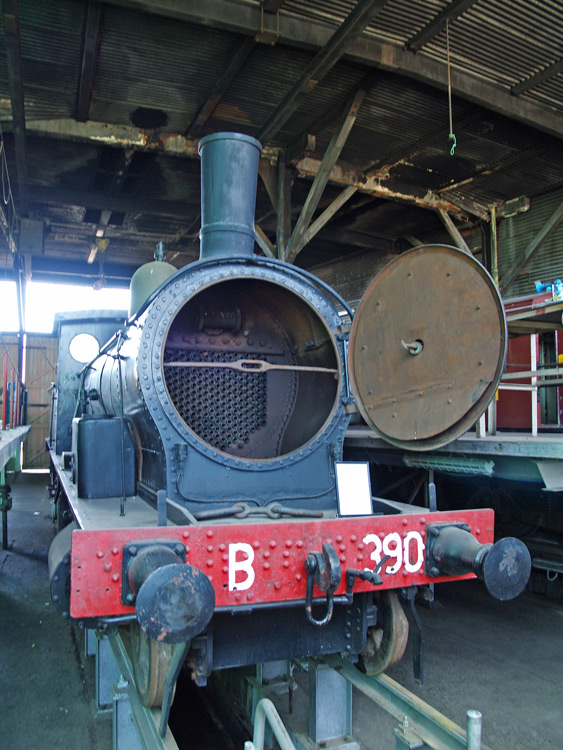
B 390 shows off its saturated steam boiler. 7 January 2012.
The main steam pipes (which curve down to the cylinders) appear to be missing.

A view of B 390's cab; unfortunately many of the control fittings are absent.
The regulator handle would have got rather hot if it usually rested in that position!
The "porthole window" style favoured by CME William Thow is evident.

Unfortunately the ex-2604 boiler fitted to 2419 doesn't have a grate or ashpan.
However it does provide for an interesting view of the foundation ring and into the firebox.
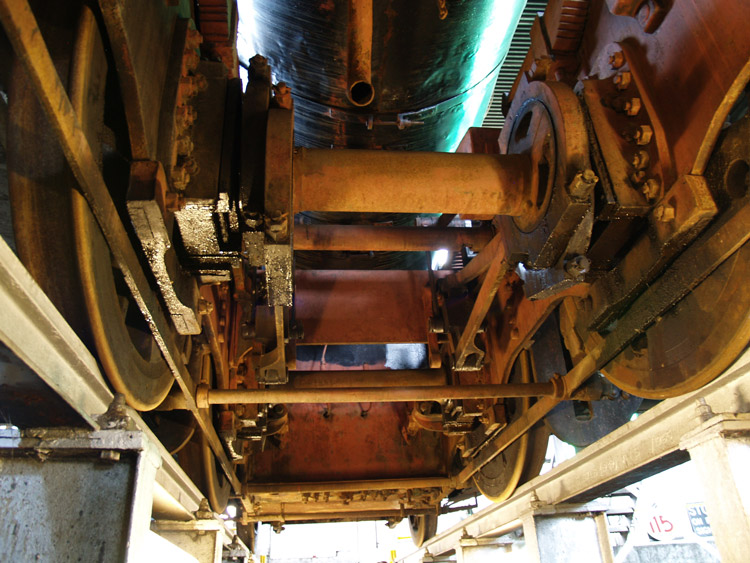
Wheels, axles, axle boxes, brake rigging, eccentric straps and valve gear.
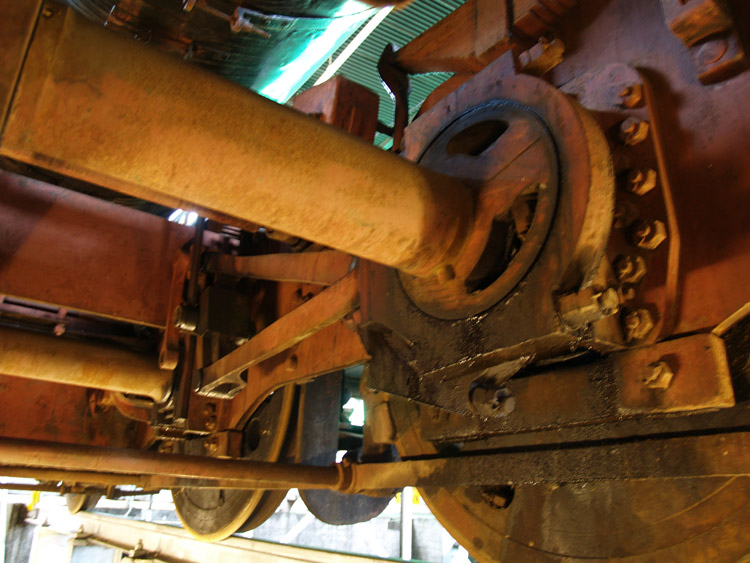
Detail of the eccentrics.
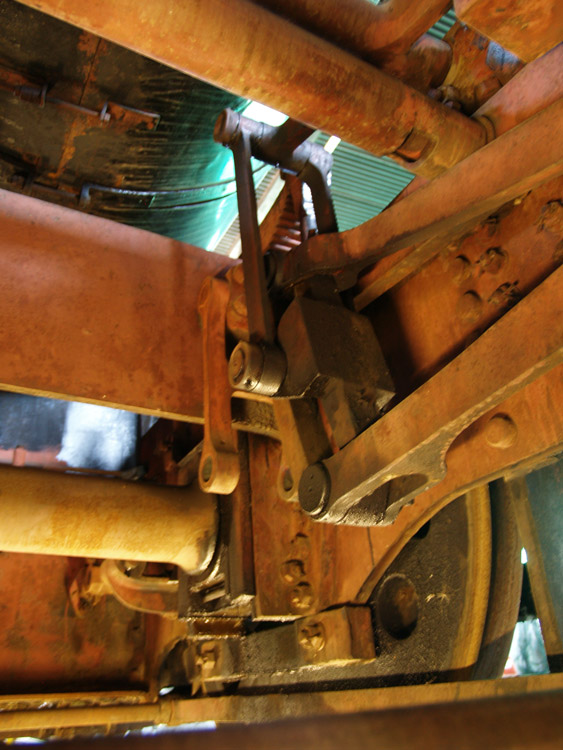
Detail of the valve gear.
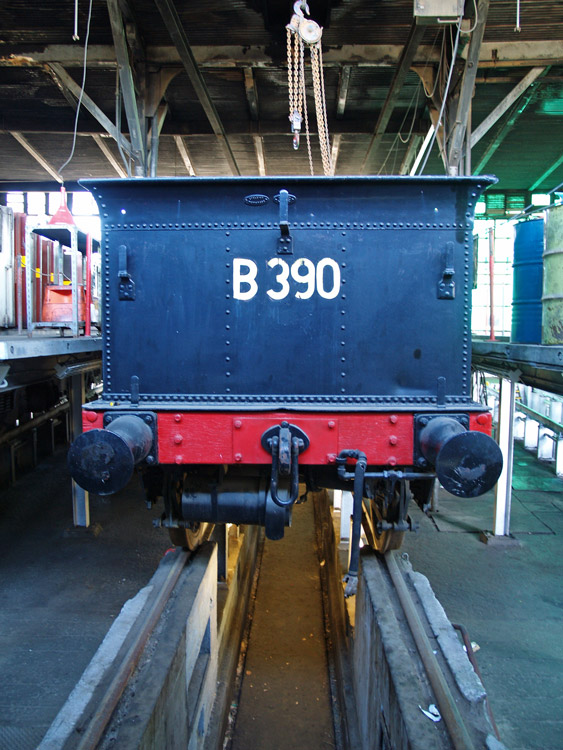
Rear view of the tender.
References
|
a |
"A
Compendium of New South Wales Steam Locomotives" compiled by Alex
Grunbach, published
by the Australian Railway Historical Society, New South Wales Division, 1989 |
|
b |
Webmaster's
observation or comment |
|
c |
Australian
Railway History, August 2012, Volume 63, No.898, "A
Locomotive Blown to Fragments - Locomotive Boiler Explosions in NSW" by
Trevor Edmonds, page 9. |
Page updated: 23 April 2015
|
Government Railways: |
|
|||||||||
|
Private & Industrial Railways: |
|